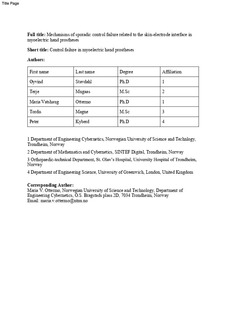Mechanisms of sporadic control failure related to the skin-electrode interface in myoelectric hand prostheses
Journal article, Peer reviewed
Accepted version

Åpne
Permanent lenke
http://hdl.handle.net/11250/2636231Utgivelsesdato
2019Metadata
Vis full innførselSamlinger
- Institutt for teknisk kybernetikk [3665]
- Publikasjoner fra CRIStin - NTNU [37236]
- St. Olavs hospital [2441]
Originalversjon
Journal of Prosthetics and Orthotics. 32(1):38–51, JANUARY 2020 10.1097/JPO.0000000000000296Sammendrag
Introduction
This study is concerned with the control of hand prostheses based on electromyograms. As the prosthesis is moved in space, the socket and electrodes can shift on the residual limb, causing changes in the observed electromyograms. These changes can be misinterpreted by the electronic controller and cause the hand to move unintentionally or fail to execute solicited movements. The goal of this study was to explore the mechanisms related to these myoelectric control failures.
Materials and Methods
To study these phenomena, conventional prosthetic EMG electrodes were augmented with force sensors to record the forces through the devices. These multimodal sensors were then used to control prosthetic hands by 15 users with losses below the elbow. The subjects performed four tasks resembling activities of daily living while the electromyogram signals, force signals, and the performance of the hands (including video images) were recorded. Eight subjects reported a total of 38 control errors, each of which was assigned to one of four failure classes and analyzed.
Results
The article shows examples of the electromyogram and force signals recorded during the control failures and discusses possible causes of the failures. Involuntary opening of the hand was identified as the most common failure, and these failures seemed to be associated with changes in the electrode-skin contact forces. It was not possible to attribute clear causes for 26.2% of the failures.
Conclusions
Knowledge of common failure mechanisms can guide improved design of sockets and electrodes and signal processing to reduce the errors experienced by prosthesis users.